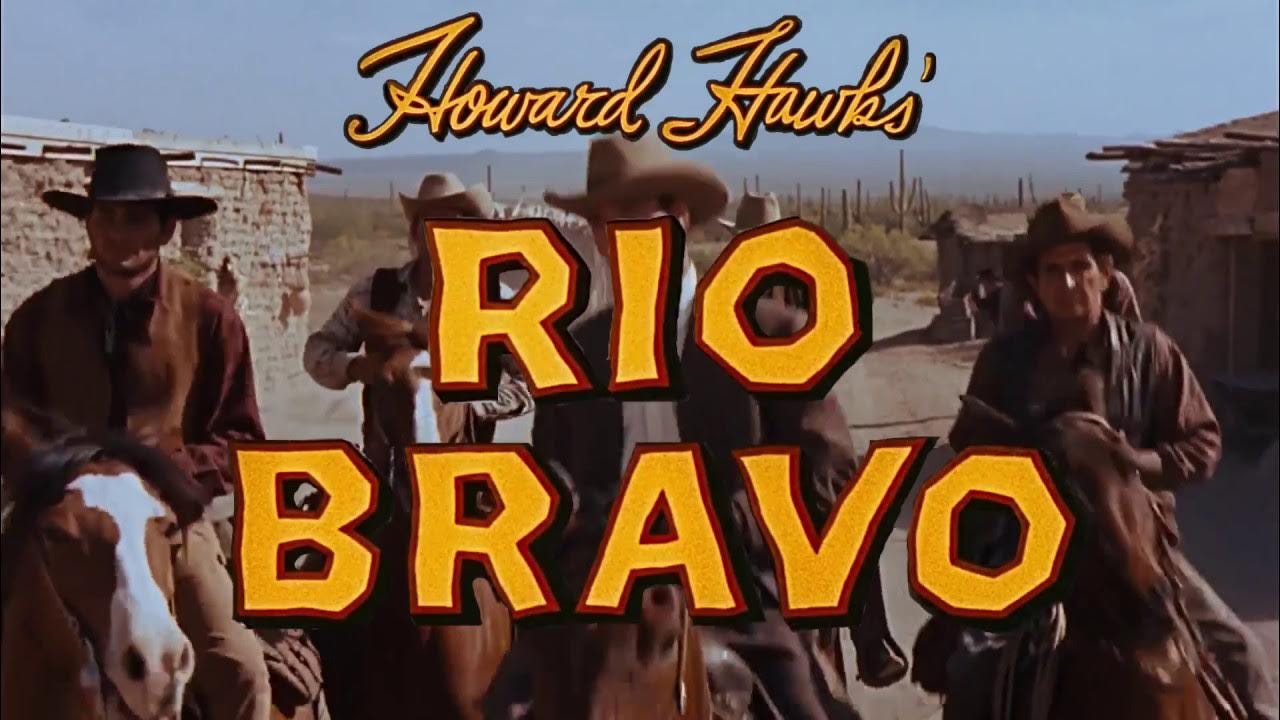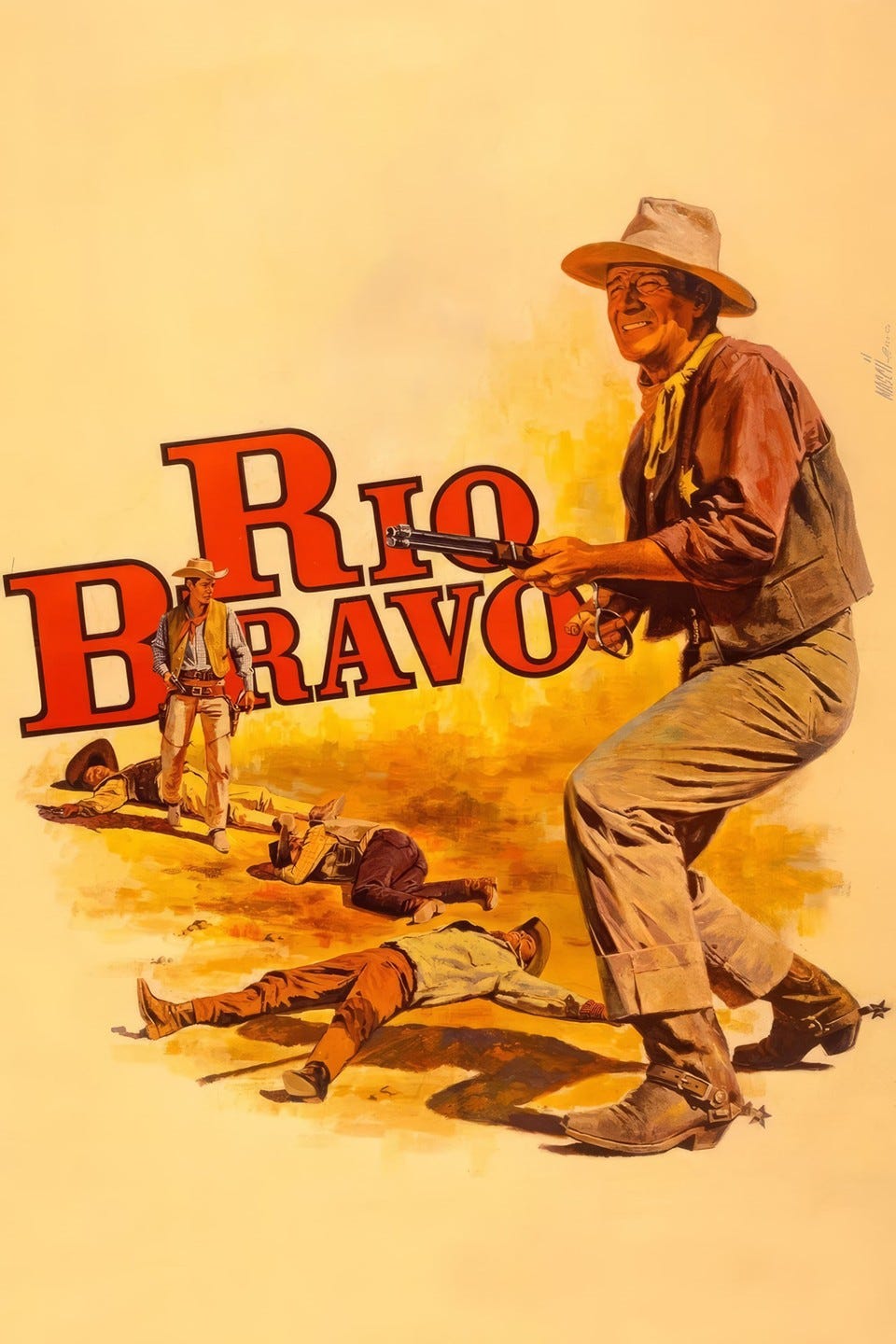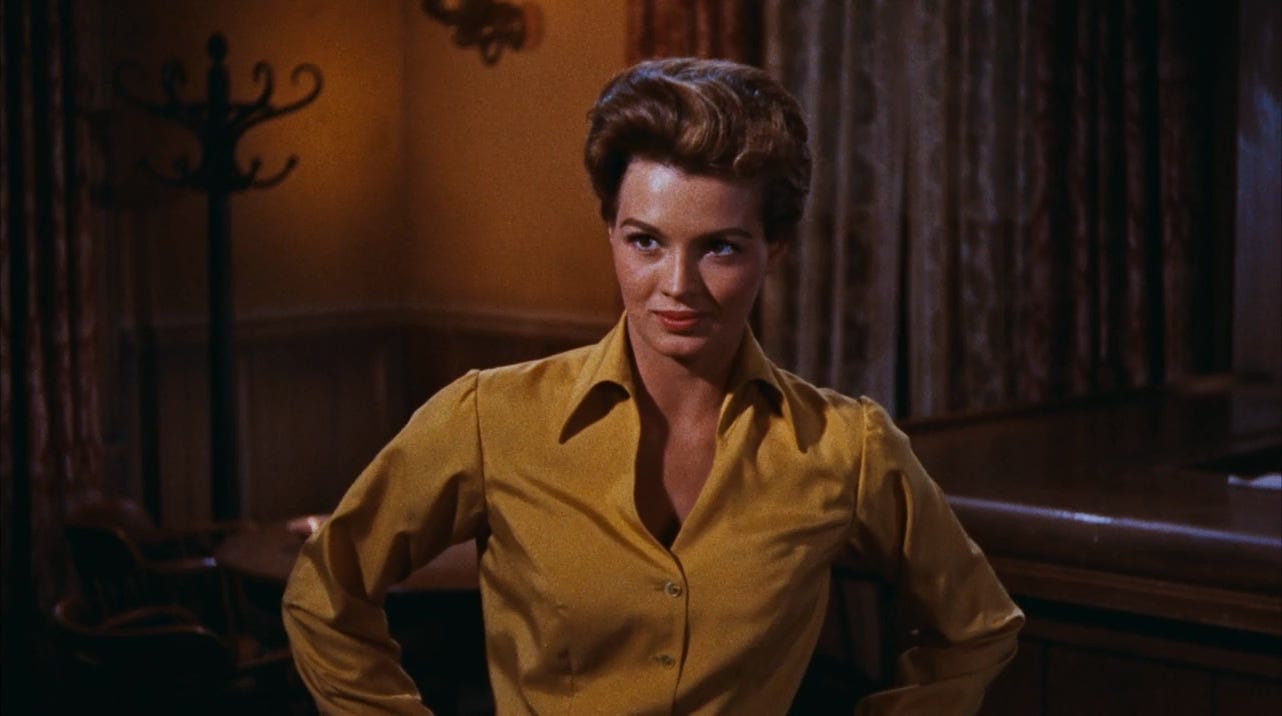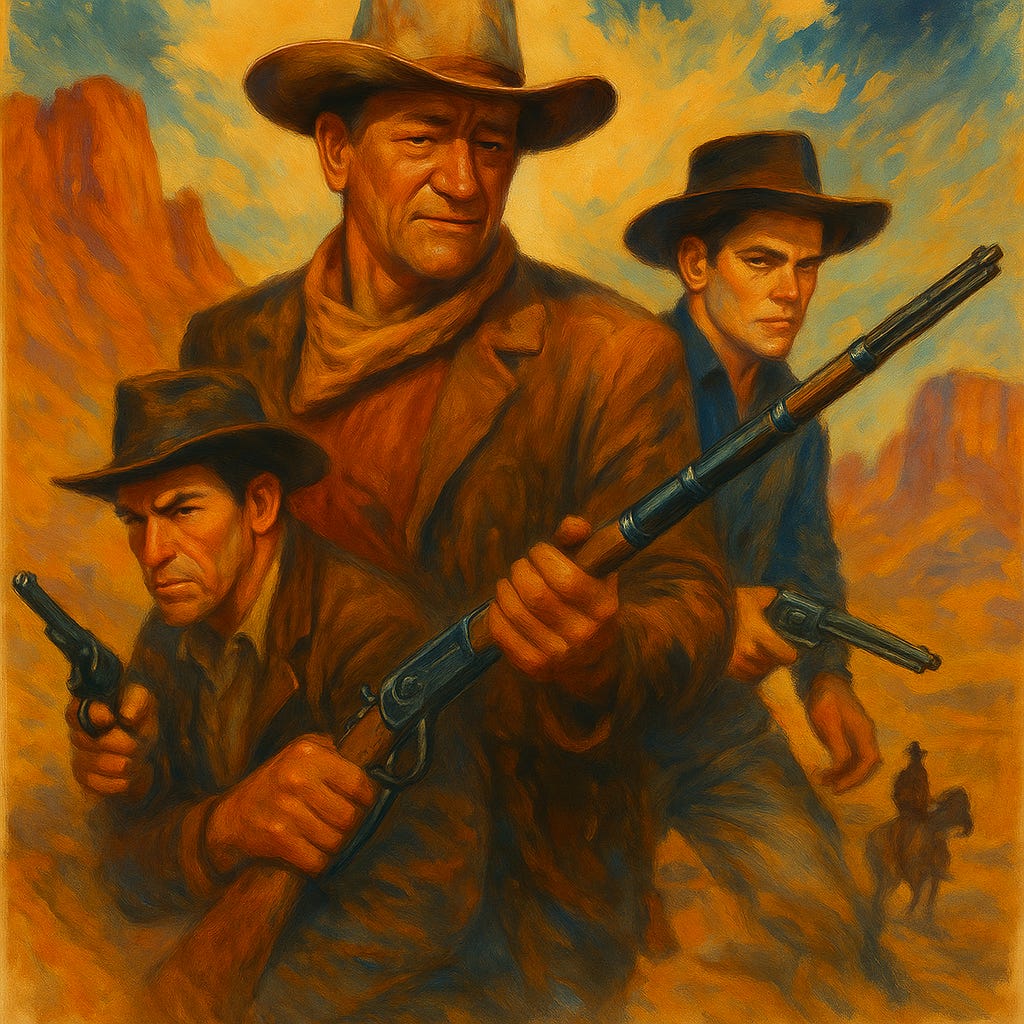The lore of 'Rio Bravo', Quentin Tarantino's 'hangout' movie
Marsellus Wallace approves.
HOLDING A BULL BY THE TAIL
Director Howard Hawks hated High Noon (1952) so much that he made Rio Bravo (1959). Hawks gave shifting reasons over the years, but the friction was always political.
I spoke with Andrew Patrick Nelson, film historian and chief curator of Western Spirit, Scottsdale's Museum of the West.
“That’s maybe what Rio Bravo is best known for,” Nelson told me. “It’s often reduced to a symbol in some larger cultural narrative.”
Released in 1959, Rio Bravo shares a creative lineage with Budd Boetticher’s Ranown Cycle—a set of six spare, Technicolor B-Westerns scripted by Burt Kennedy and produced by Harry Joe Brown and Randolph Scott, who also starred. Scott was 61 when filming Ride Lonesome, a low-budget production shot in just 17 days.
These films bridged the noble early Westerns and the grittier revisions to come. Minimalist and haunting, the Ranown Cycle has since earned Criterion acclaim. As Nelson puts it, they’re like potato chips: you can’t stop at just one.
Rio Bravo has a similar pull. Quentin Tarantino once called it his favorite “hangout movie”—a film where the stakes matter less than the pleasure of spending time with characters you enjoy. A film built on lingering moments and loaded pauses. He once said there’d be no second date if someone didn’t like Rio Bravo
Starring John Wayne, Dean Martin, Ricky Nelson, and Angie Dickinson, the movie lets the plot unfold inside the richness of its characters.
RIO NOON
I began my now-defunct Wednesday Western series with High Noon, praising it for what I saw as a rugged, individualist parable—a film that valorized moral clarity and personal responsibility in the face of institutional cowardice. I praised it as a rugged, individualist parable—staunchly anti-communist, even libertarian.
But not everyone agrees.
High Noon centers on a town marshal, played by Gary Cooper, who’s abandoned by the townsfolk as he prepares to face a returning outlaw. Most of the film focuses on his pleas for help as killers close in. Nobody steps up—until his pacifist wife intervenes.
This is why Hawks hated it: He saw collectivists who only care about themselves.
So did Wayne—he called it “the most un-American thing I’ve ever seen.” To him, and to Hawks, a sheriff who begs the townsfolk for help—and needs his wife to save him— was a disgrace, lacking the heroism of a Western protagonist.
So Hawks made Rio Bravo.
NEW PROFESSIONALS
“Instead of a sheriff going door-to-door asking the weak for help,” Nelson said, “you’ve got a team of professionals.” John Wayne’s Sheriff Chance doesn’t have to rally the town—they’re so patriotic that he has to turn them away: “They don’t ask for help. They handle it themselves.”
Structurally, High Noon is a slow-burn morality play: talky, somber, nearly humorless.
“You could argue it’s even a little pretentious,” Nelson said.
The preacher monologues, the old marshal sermonizes, and Gary Cooper’s Will Kane spends most of the movie looking like he’s about to cry.
Rio Bravo, by contrast, is jovial. There are songs. There’s humor. Angie Dickinson flirts circles around Wayne. And yet, it has weight.
Not because of the external plot—no one’s saving the world—but because the emotional stakes feel real.
“The drama,” Nelson told me, “is in the relationships: Chance and Dude, Chance and Feathers.”
That shift—from external stakes to internal loyalty—is why some scholars call Rio Bravo the beginning of a new kind of Western: the “professional Western.”
SIX GUNS
Sociologist Will Wright coined the term in Six Guns and Society, arguing that films like Rio Bravo marked a transition in American mythology. The Western genre had matured beyond stories about righteous townsmen or righteous outlaws, focusing instead on men apart from society, defined by their skills, bonded by their code.
“They don’t need the townspeople to cheer them on,” Nelson said. “They’re not looking for external validation. They just do the job.”
That archetype—cool competence, quiet camaraderie, the emotional weight of unspoken duty—starts to look a lot like the technocratic shift in postwar America.
“We began to give over our autonomy,” Nelson said. “To the professional class. To the experts. To the engineers of society.”
BLACKLISTED
The Western evolved with the country, whether Hawks meant it to or not.
And yet, High Noon remains the more overtly political film—especially in hindsight. Its screenwriter, Carl Foreman, had been blacklisted for alleged communist sympathies. The film has often been interpreted as a parable about Hollywood’s moral failure during the McCarthy era.
Even Gary Cooper complicates things. The man who played Will Kane was a proud conservative Republican, a founding member of the Motion Picture Alliance for the Preservation of American Ideals, who testified before HUAC in 1947. He rejected scripts he believed were “tinged with communist ideas.” So it’s hard to picture him playing the stooge of the Communist Party.
The allegory may have come after the fact—a retrofitted narrative Hollywood likes to tell itself.
But Nelson isn’t convinced: “I’ve got a friend,” he said, “who looked at hundreds of contemporary reviews. Not one mentioned the blacklist.”
SORRY DON’T GET IT DONE, DUDE
Wayne’s character, Sheriff John T. Chance, has backup: Dean Martin’s washed-up gunfighter known only as “Dude.”
The friendship between Chance and Dude, played by Wayne and Martin, gives the film an emotional anchor. You fear they might not all make it.
Martin adds flesh and vertigo to Dude’s fight for sobriety, a man clawing his way back from disgrace.
“Don’t set yourself up as being so special, thinking you invented the hangover,” Chance tells a rattled and struggling Dude.
A musical moment serves as the soul of the movie. The boys are lazing around in the jailhouse, killing time, when Dude picks up a guitar and starts quietly singing “My Rifle, My Pony and Me.”
Sheriff Chance leans forward, as does Walter Brennan’s cantankerous “Stumpy.”
Then Ricky Nelson’s cool kid “Colorado” joins in with his Rockabilly tremble.
That scene gets me every time. It comes out of nowhere to slow you down
When I told film historian Andrew Patrick Nelson about that moment—the surprise of it, the unexpected tenderness—he lit up. “Yes, yes, yes,” he said. “My Uncle Ricky,” with a laugh.
“That scene captures what Rio Bravo is,” he added. “It’s casual, even indulgent. Like they were having fun making the movie—and Hawks had enough clout to just stop the story for two songs.”
The narrative halts. Time softens. In a genre known for stoicism and grit, here are two men crooning in harmony while two others lean back and smile.
It’s perfectly out of place, and that’s the point: Rio Bravo is “filled with these moments,” Nelson said, “where we’re not expecting what we get.”
A WOMAN WALKS INTO A WESTERN
As Nelson put it, Rio Bravo is about “self-reliance and camaraderie.” Hawks’ characters aren’t asking for permission to act.
Angie Dickinson’s Feathers seduces and taunts, keeping Chance (Wayne) off balance. Hawks let Dickinson take the lead because he knew Wayne couldn’t carry the romance alone.
And it works. Feathers is unpredictable, a little dangerous. Is she in it for love—or the thrill?
She spends the film outwitting Wayne’s Sheriff Chance, flipping the dynamic you’d expect from a 1950s Western.
The action, by comparison, is almost an afterthought. “The stakes don’t need to be huge,” he said. “We already care.”
GABBY HAYES
Walter Brennan plays Stumpy, and if you’ve ever seen a cartoon with a cranky old man shouting nonsense in a gravelly rasp, that’s Brennan’s voice echoing through the decades. In the shadow of Gabby Hayes, Brennan practically invented the “old coot” archetype. But as Andrew Patrick Nelson reminded me, it’s a bit of a shame he got stuck there.
“Brennan’s voice is instantly recognizable,” Nelson said. “You hear it in every parody of an old timer now. But it’s also a little unfortunate, because he had an incredible career.”
Three Oscars. A range that stretched far beyond comic relief. Before he was Stumpy—the toothless jailhouse firebrand with a shotgun and a death wish—he played Judge Roy Bean in The Westerner, a role that won him an Academy Award. He was the menacing Old Man Clanton in My Darling Clementine. Dangerous. Convincing. At times, terrifying.
“Same voice,” Nelson pointed out, “but different inflection. He knew what he had, and he knew how to use it.”
By the late ’50s, though, the Western was flooded with coots. The genre—and its actors—were aging. Brennan leaned into it, or maybe just let it happen.
Stumpy re-established the blueprint—crotchety, loyal, comedic. And when El Dorado came along, Hawks swapped in Arthur Hunnicutt to play basically the same character. Different name, same old man with a shotgun and a heart of gold.
Nelson said he likes showing his students Brennan’s darker roles before they get to Rio Bravo. They laugh at Stumpy, then recoil at Judge Bean. It reminds them that range is a mastery of style. It’s about knowing what power you have and choosing how to turn the dial.
GOOD OLE DAYS
“The interesting thing when talking about a Golden Age is that sometimes the golden age expands over time,” Nelson told me. “And as it expands, the number of films that actually represent it gets smaller.”
By the 1950s, critics were already mourning the Western’s decline.For them, the true Golden Age had come and gone with Stagecoach and the wartime boom: 1939 to 1945. Everything after, they said, was self-conscious, pastiche.
This narrative shifted in the 1970s. Suddenly, the Golden Age stretched from Stagecoach all the way through The Wild Bunch.
A film like Rio Bravo, once viewed as a tonal departure, was recast as classic. “We would’ve seen it differently at the time,” Nelson said. “We would’ve seen it—and films like Shane or High Noon—as something new, maybe even a little subversive.”
Cultural memory changed.
The Western’s timeline got flattened into myth. Rio Bravo, despite being a very different kind of film, was absorbed into the canon.
Hawks became one of the pantheon directors. Wayne became the ur-cowboy. And Rio Bravo became part of a 30-year “Golden Age” that never changed—a historical illusion that only works when you ignore the details.
As Nelson put it, the idea of a "classic Western" serves a function: it gives people permission to say that everything afterward—however violent, ironic, or weird—is a fall from grace.
The implication is clear: Unforgiven is not Shane. Deadwood is not Rio Bravo. Something was lost.
But Nelson doesn’t buy that narrative. “To me, The Wild Bunch is a lot more like Rio Bravo than Rio Bravo is like Stagecoach,” he said. History doesn’t move in neat little boxes. Genres evolve, mutate, circle back.
French postmodern philosopher Gilles Deleuze believed that film can be philosophy, capable of a “continuous, infinite flux,” a process of and then…and then…and then…




















One of my favorite westerns. Interesting that this was made as kind of an antidote to High Noon. So you have one movie waiting for bad guys, and one man begging for help, another movie where the town takes care of its own, but there is another one with a similar theme. In “High Plains Drifter” you have the town about to be in peril, and the townspeople convince the “drifter” to help them. That doesn’t work out so great for them. Be careful what you wish for!
Let’s face it, John Wayne as he got older was not the hunky sex symbol like Clint Eastwood was back in the day, but there is something about being manly that is attractive (as a woman, I can attest to that). My favorite John Wayne movie is not a western. “Hatari” is a classic in a similar way to “Rio Bravo”. Fabulous cast, with camaraderie the seems genuine, and even a bit of a musical interlude with Henry Mancini’s “Baby Elephant Walk”.
So happy to see Wednesday Western making a comeback!